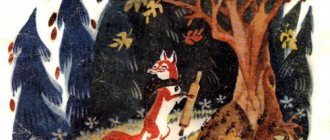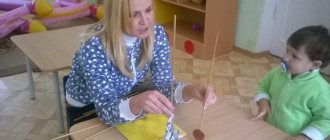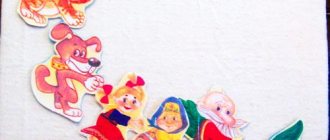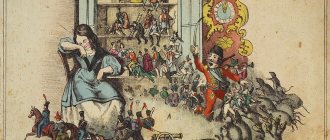Progress of the game
- Children! Look what I have in my hands? Today I was walking along the path to kindergarten and found a beautiful box.
-Are you wondering what's in it? (I'm trying to open it, but it won't open)
We won't be able to open it until we solve the riddles. Are you ready to work hard?
Lives under the porch
Ring tail (Dog)
But he doesn’t know about water (Cat)
sharp teeth. (Mouse)
Stuck tight
In the garden. ( Turnip )
Children guess the riddle, and the teacher takes toys out of the box. Ay, well done! All my riddles have been solved! Or maybe you know in which fairy tale we met these characters?
Children: fairy tale " Turnip "
Educator: Well done guys, you got it!
-And since you have guessed all the riddles, I have a surprise for you, look, I have a magic chest. Want to know what's in there? (Yes)
.
And for the chest to open, you must say the magic words: chok-chok, open the chest.
-Grandfather planted a turnip . (Grandfather imitates planting a turnip : digs, loosens, plants, waters; sits on a chair near the house. The turnip begins to grow )
- The turnip has grown big .
- Grandfather pulls a turnip . Can't pull it out.
- Grandfather called grandma. (Grandfather calls grandmother, grandmother comes up and helps grandfather pull the turnip )
- Pulling a turnip . They can't pull it out. The woman called her granddaughter. (The grandmother calls her granddaughter, the granddaughter runs up, everyone pulls the turnip )
- Pulling a turnip . They can't pull it out. The granddaughter called Zhuchka. (The granddaughter calls Zhuchka. Zhuchka runs and barks. Everyone is trying to pull the turnip )
“They pull and pull, but they can’t pull the turnip .” Then Bug called the cat.
- They pull the turnip , but they can’t pull it out. The cat called the mouse. (The mouse runs and squeaks. Everyone pulls and pulls out the turnip )
(Improvisation to folk music )
- That’s the end of the fairy tale . It's so good that everything ended well. Why did you manage to pull out the turnip ? (Because everyone pulled together, together)
.
People say : “Take it together – it won’t be too heavy
.
The most difficult task can be dealt with if everyone tackles it together. I wish you to remain friendly, always come to each other’s aid. Love fairy tales , they have a lot of wisdom.
Dramatization of the Russian folk tale "Kolobok" Topic: Dramatization of the Russian folk tale "Kolobok". Goal: To arouse children’s interest in fairy tales and mummers; promote speech activation.
Dramatization of the Russian folk tale “Hen Ryaba” in the first junior group Dramatization of the Russian folk tale “Hen Ryaba” Taught by the teacher 1 ml. gr. Kudukhova A. Kh Purpose: To arouse interest in fairy tales and mummery. Develop.
Lesson notes on theatrical activities. Dramatization of the Russian folk tale “Turnip” Junior preschool age. Educator: Kataeva Marina Anatolyevna. Goals: introducing children of primary preschool age to Russian folklore.
Dramatization of the Russian folk tale "Teremok" Dramatization of the Russian folk tale "Teremok". Goal: • to develop in children a keen interest in theatrical play; • Teach children actively.
Scenario of an open event in the second junior group “Game-dramatization based on the Russian folk tale “Turnip” Municipal budgetary preschool educational institution Kindergarten “Firefly” Open event in the second junior group.
Abstract of the educational activity on theatrical activities in the first junior group “Dramatization of the Russian folk tale “Turnip”” Leading educational area: “Artistic and aesthetic development” Goal: to create conditions for introducing children to theatrical activities.
Lesson summary for the middle group “Dramatization of the Russian folk tale “Teremok” Lesson summary for the middle group “Dramatization of the Russian folk tale “Teremok” Goal: Creating favorable conditions for creative activity.
Open lesson. Dramatization of the Russian folk tale "Teremok" Dramatization of the Russian folk tale "Teremok" in the group "Sun". Goal: to maintain a sustainable interest in theatrical and gaming activities.
Entertainment in the early group “Dramatization of the Russian folk tale “Zayushkina Hut” Entertainment in the early group “Dramatization of the Russian folk tale “Zayushkina Hut” Progress of entertainment: (Children sit in a semicircle on chairs).
Scenario of the holiday-fairy tale “Turnip” (based on a Russian folk tale) Fairy tale “Turnip” (based on a Russian folk tale.) Author - Buyanova G. S. - teacher at MDOU No. 20, Zheleznogorsk. Kursk region. Active.
Source
Summary of GCD for children of the middle group. Theatrical game based on the fairy tale “Turnip”
Elena Kuznetsova
Summary of GCD for children of the middle group. Theatrical game based on the fairy tale “Turnip”
Summary of GCD for children of the middle group
Theatrical game based on the fairy tale " Turnip "
Goal: To bring children to the understanding that diligence and joint work give good results and a great mood.
1. Enrich children's .
2. Expand the lexical meaning of words.
3. Learn to compose a fairy tale according to plan , without deviating from the topic, without repeating the plots of your comrades.
4. Learn to agree adjectives with nouns in gender and number.
Cognitive and speech tasks:
1. Development of free communication, development of dialogic and monologue forms of speech;
2. Reading poetry and telling proverbs ;
Scenario for dramatization of the fairy tale “Turnip” (middle group)
Irina Ilyukhina
Scenario for dramatization of the fairy tale “Turnip” (middle group)
Author Ilyukhina Irina Mikhailovna
MBDOU kindergarten No. 145 “Ogonyok”
Bryansk
SCRIPT FOR DRAMATIZATION OF THE TALE " TURNIP "
middle group
Arouse interest in theatrical performances; desire to participate in them.
Development of expressiveness in speech, movements, creativity.
Integration: “Speech development”
,
“Cognitive development”
,
“Artistic and aesthetic development”
Repka - adult
The hall is decorated “Autumn vegetable garden”
a turnip sits in the middle (adult, grandfather walks around (adult, spreads his arms, strokes the turnip .
Grandfather: Come in, come in guys!
Look what kind of turnip I grew (walks around the turnip )
.
Not in the forest. Not on the mountain
In grandpa's yard
The miracle turnip has grown.
I brought the leaves to the sun.
Dramatization game based on the fairy tale “Turnip” in the middle group
DRAMATIZATION GAME “TURNIP”
»
Based on a Russian folk tale.
Objectives: 1. Reduce aggression in children, unite the group, evoke positive emotions; 2. Teach children to understand and relate the word to familiar household items, toys; perform movements, actions in accordance with the text, follow the development of the plot; 3. Develop in children the expressiveness of intonation and facial expressions; 4. To foster interest in collective dramatization games.
Characters: Leading teacher, grandfather, woman, granddaughter, dog Zhuchka, cat Murka, mouse.
Preparing for the dramatization game:
Game “Assemble a fairy tale using a chain of pictures “Turnip”, illustrations (artist V. Losin).
Equipment: hat for grandfather, stick (maybe a beard); scarf, apron for a woman; sundress, scarf for granddaughter; attributes for the image of animals. There may be other characters at the request of the children. Watering can, spatula, turnip replica, hoop (bed) Game progress
. When organizing the first game, tell the children that they are visiting a Russian folk tale today. Which? Let them figure it out for themselves. Show them the attributes, maybe they will tell the children what fairy tale they will encounter. By trying on hats for different children, make them want to play. There will be many of them. But for the first game, choose those who can best fulfill the role and will be a model for others. The rest of the guys are still spectators. Together with them, decide where the grandparent’s family will live and where to place their vegetable garden. Remind the child “artists” that they will be included in the game as the story progresses, and begin to tell it, since the role of the presenter belongs to the teacher. Leading teacher: Grandfather planted a turnip. (Using facial expressions and gestures, he expresses approval of his grandfather’s diligence and hard work.) The turnip has grown very, very big. (Astonished by its size.) The grandfather began to pull the turnip out of the ground. All: He pulls and pulls, but he can’t pull it out. Leading teacher. This is how my grandfather raised a turnip, and he can’t handle it! But he has many helpers. Who should we call? Grandfather: Grandma, help! Leading teacher: Grandma doesn’t come, she doesn’t hear. He is busy with housework. Shall we call grandma? All: Grandma, help! Grandma: I'm coming, I'm coming! Presenter: Grandma for grandpa, grandpa for the turnip - they pull and pull, but they can’t pull it out. (Expresses surprise at how firmly the turnip sits in the ground.) The grandmother called her granddaughter. Grandmother: Granddaughter, help! Presenter-educator: The granddaughter is in a hurry to help the old people. Granddaughter: I'm coming, I'm coming! Leading teacher: Granddaughter for grandma, grandma for grandpa, grandpa for the turnip... Everyone: They pull and pull, but they can’t pull it out. (Surprised) Leading teacher: The granddaughter called the dog Zhuchka. The bug didn't stay long. Bug. Woof-woof-woof, I'm running! Everyone: the bug for the granddaughter, the granddaughter for the grandmother, the grandmother for the grandfather, the grandfather for the turnip - they pull and pull, they cannot pull it out. (Very upset.) Leading teacher: Bug called the cat. Bug: Murka, help! Leading teacher: The cat doesn’t walk, lies basking, doesn’t listen to the Bug. Let's call everyone together. All: Murka, go! They can't cope without you! Murka: I'm coming, I'm coming! Everyone: the cat for the Bug, the Bug for the granddaughter, the granddaughter for the grandmother, the grandmother for the grandfather, the grandfather for the turnip - they pull and pull, they can’t pull it out. (The patience of the audience and the “actors” is running out; there is despair on their faces from endless failures.) Presenter-educator: The cat called the mouse. The mouse squeaks in fear, but still rushes to help. (Encourages the mouse, calms it down.) Everyone: Mouse for the cat, cat for the Bug, Bug for the granddaughter, granddaughter for the grandmother, grandmother for the grandfather, grandfather for the turnip - they pull and pull, they pulled out the turnip! (They rejoice.)
Summary of a lesson on speech development in the middle group of kindergarten. Dramatization of the fairy tale “Turnip”
Summary of educational activities on speech development in the middle group through play - dramatization based on the fairy tale “Turnip”
Duration of educational activities:
20 min.
Goal: creating conditions for the development of children’s speech through the game-dramatization of the fairy tale “Turnip”. Objectives: educational:
expand the child’s general horizons about theatrical activities through fairy tales;
developing:
to develop speech activity, creativity, the ability to convey the image of a fairy-tale hero through gestures and facial expressions);
educational:
to cultivate friendly relations in the children's team.
Types of children's activities: gaming, communicative, motor, musical. Equipment: invitation to the fairy tale “Turnip”, chest with a map, house model, masks of fairy tale heroes, cut-out pictures of fairy tale heroes (animals), clearing (hoop) with turnips, rope walkway, letter. Technical support: Power Point software: slides with demonstration pictures, audio recording of “Fanfare”. Stages of activity Contents Problem solved at this stage Child's activity Adult's activity Proposed result Part 1. Org. moment Greeting Surprise moment. (Knock on the door. A storyteller in a folk costume enters.) I really love fairy tales, and you? Have you ever been to the theater? Do you want to visit the theater? Here's an invitation for you, I'll take you to the theater. (children go to the music room) Get most of the children interested. Switch children from gaming activities to educational ones. Completion of children's independent activities. Organizing children for educational activities. Get as many children interested as possible. The child's ability to make his own decisions. Part 2. Main Creation of a problem situation (Slide 1. Image of the theater) Sit down, now the fairy tale will begin. (The fanfare sounds and then stops) What happened? There won't be a show? (Presentation of the chest). Guys, look, what's here? What do you think is inside? Inside is a map with tasks: “Walk along the map, find all the heroes of the fairy tale and become the heroes of the fairy tale yourself.” Involve children in educational activities. The ability to listen to a problem and the ability of children to resolve the situation. Organization of children through the creation of a problem situation. Demonstration of children's desire to solve a problem situation. Motivation for activity Conversation. - Guys, what should we do? Do you want to go on a journey and meet heroes? Encourage children to have an open dialogue with the teacher. Children's reasoning on the proposed questions. Conversation using leading questions. Ability to conduct dialogue with adults and peers. Performing actions. Show a presentation based on the tasks in the map. (Slide 2). A game-conversation for the development of dialogical speech (rhymes about grandparents, children’s description of their qualities). (Slide 3). Game – sketch “Turnip” (movements with words). (Slide 4). A riddle about a granddaughter showing illustrations from fairy tales. Game “Where does the granddaughter live?” Work in subgroups. Puzzle game “Collect the picture” (animals from a fairy tale) Guide children to the goal in completing tasks. Develop creative imagination, fantasy, the ability to perform movements in accordance with the text, and expand vocabulary. Discussion conversation with adults. Perform movements according to the text. Guessing riddles, ability to work in subgroups. Explanations of slides, participation in dialogue and explanation of the work to be done. Construction of a speech utterance. Theatrical activity - Guys, what heroes did you meet along the way? What is the name of the fairy tale? Would you like to become an actor? Choose your role and we will show you a fairy tale. Children's dramatization of the fairy tale "Turnip". Invite the children to take on the role of any fairy tale hero and show the fairy tale. Show the children the fairy tale. Verbal instruction from the teacher. Showing children's interest in taking a certain role in joint play activities, based on the desires of the child himself. Part 3. Final Analysis of performance results, reflection - Which tasks were especially interesting?
-Did you like all the tasks? Was it difficult to play roles? Which role did you like best? Summing up the results of educational activities. Answer questions. Evaluate their work and the work of other children. Ask leading questions about the work done. Analysis of completed tasks by children. Download Notes on speech development in the middle group through play - dramatization of the fairy tale “Turnip”
We recommend watching:
Summary of a lesson on speech development in the middle group on the topic: “Ukraine is my native land” Notes on the development of speech in the middle group Notes on the lexical topic “Transport” for children 4-5 years old with severe speech impairments Notes on the development of speech in the middle group middle group
Similar articles:
Summary of a lesson on speech development in the middle group on the topic “Our Street”



